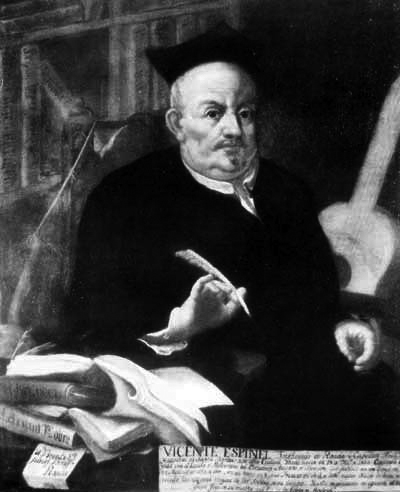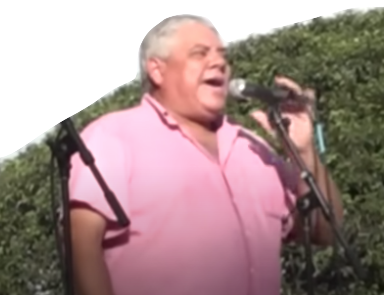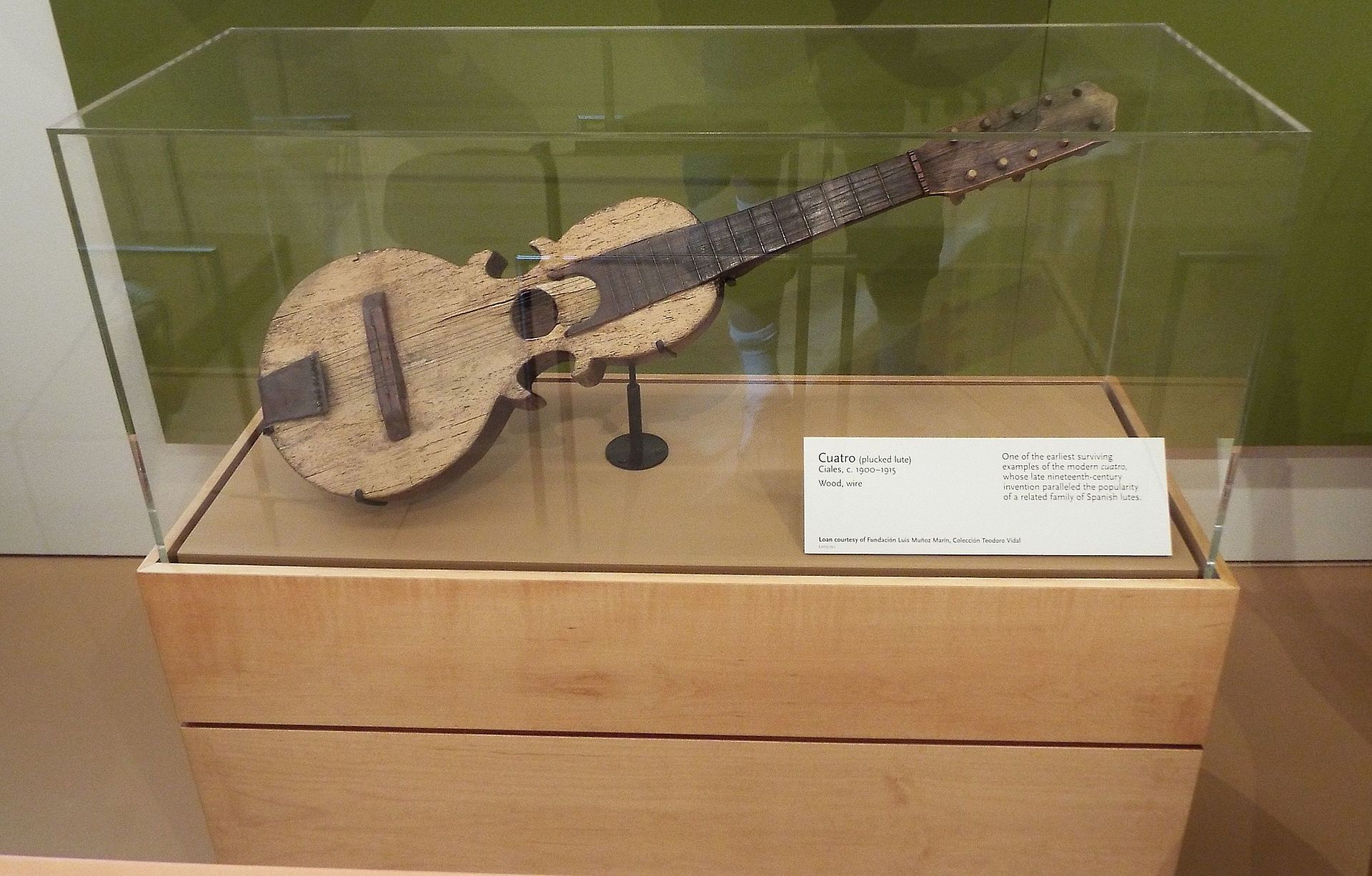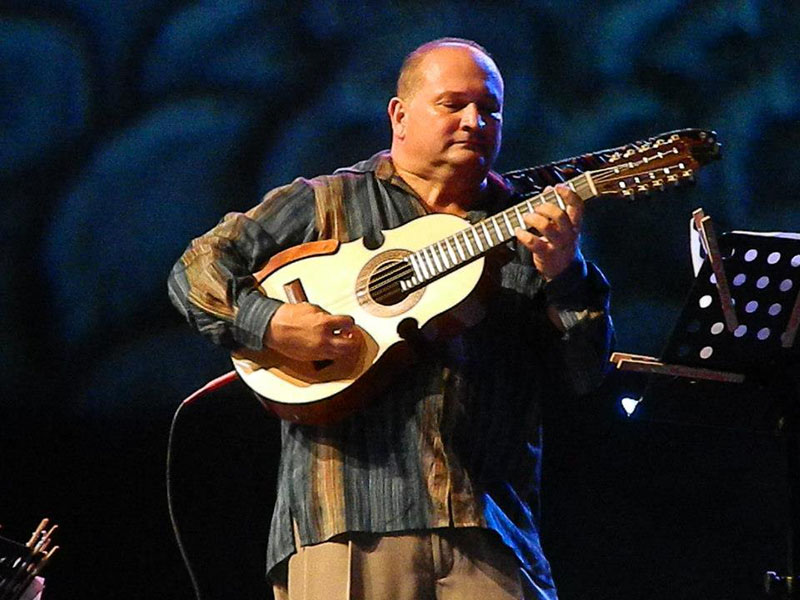

デシマ
Décima
Vicente
Gómez Martínez-Espinel, 1550-1624//AGUINALDO JIBARO
CON LOS TROVADORES DE DECIMANIA CON EDWIN COLON ZAYAS Y TALLER CAMPESINOよ
り
☆ デシマ(décima)は一行八音節からなる十行でで 構成されるスタンザ(詩連)のこと。最もポピュラーな形式は、スペイン黄金時代の作家、詩人、音楽家であるビセンテ・エスピネル( Vicente Gómez Martínez-Espinel; 1550年-1624年)にち なんで、デシマ・エスピネルと呼ばれる。
| A décima is a
ten-line stanza of poetry. The most popular form is called décima
espinela after Vicente
Espinel
(1550–1624), a Spanish writer, poet, and musician from the Spanish
Golden Age who used it extensively throughout his compositions.[1] The décima deals with a wide range of subject matters, including themes that are philosophical, religious, lyrical, and political. Humorous décimas would typically satirize an individual's weakness or foolish act. A decimero would frequently challenge the target of the satire or his/her defender to respond in kind with a décima, thereby setting up a duel that tests the originality and wit of contending composers.[2] |
デシマは10行で構成されるスタンザ(詩連)。最もポピュラーな形式
は、スペイン黄金時代の作家、詩人、音楽家であるビセンテ・エスピネル(1550年-1624年)にちなんで、デシマ・エスピネルと呼ばれる。 デシマは、哲学的、宗教的、叙情的、政治的なテーマなど、幅広い主題を扱う。ユーモラスなデシマは通常、個人の弱さや愚かな行為を風刺する。デシメロ(デ シマを歌う詩人や歌手)は、風刺の対象やその擁護者に対し、デシマで応戦するよう挑むことが多く、それによって、争う作曲家の独創性と機知が試される決闘 が設定された[2]。 |
| Styles Latin America and Spain The décima in all Latin America and in Spain is a style of poetry that is octosyllabic and has 10 lines to the stanza. The espinela rhyming scheme (ABBAACCDDC) is the de facto scheme in use. It is spoken, sung and written throughout Latin America with variations in different countries. It is often improvised.[3] Each country has its own melody and tone ("tonada") and a different instrument, but the style and structure is exactly the same. A person who writes or improvises décima is known as a decimista or decimero. Décima Afro-Pacífica The décima afro-pacífica is an extension of the décima espinela into four décima stanzas with an introductory four-line stanza (or copla) that often summarizes the entire work using the 10th line of each décima stanza, making a total of forty four octosyllabic lines (one quatrain plus four décima espinelas).[4] The term "octosyllabic" may be misleading to English speakers as in Spanish the term refers to "metric syllables", meaning that the number of syllables is counted by the amount of spoken syllables the line carries. For example the line "Allá arriba en esa loma" carries ten grammatical syllables, but when spoken naturally it sounds like "A lláa rri baen e sa lo ma" which amounts to 8 spoken syllables. The variations based on the word's accents (agudas, graves, and esdrújulas) in the last word of the verse also allows for different numbers of metric syllables:[5] If ending in an "aguda" word like "corazón" the line should have 7 metric syllables. If ending in a "grave" word like "loma" the line should have 8 metric syllables. If ending in an esdrújula word like "brújula" then the line should have 9 metric syllables. |
スタイル ラテンアメリカ全域とスペインのデシマ ラテンアメリカ全域とスペインのデシマは、8音節で1スタンザが10行の詩のスタイルである。エスピネラ韻律(ABBAACCDDC)が事実上使用されて いる。ラテンアメリカ全土で話され、歌われ、書かれるが、国によって違いがある。即興で作られることも多い[3]。 国ごとに旋律や調性("tonada")が異なり、楽器も異なるが、スタイルや構成は全く同じである。デシマの作曲や即興演奏をする人は、デシミスタまた はデシメロと呼ばれる。 アフロ・パシフィカのデシマ デシーマ・アフロ・パシフィカは、デシーマ・エスピネーラを4つのデシーマ・スタンザに拡張したもので、各デシーマ・スタンザの10行目を使って作品全体 を要約する4行の序奏スタンザ(またはコプラ)を持つことが多く、合計44行の8音節の行(1つのクアトレーン+4つのデシーマ・エスピネーラ)となる [4]。 スペイン語では「メートル音節」、つまり音節の数はその行が持つ話し言葉の音節の量によって数えられるため、「八音節」という言葉は英語話者には誤解を招 くかもしれない。例えば、"Allá arriba en esa loma "というセリフは、文法的には10音節だが、自然に話すと "A lláa rri baen e sa lo ma "と聞こえ、8音節になる。節の最後の単語における単語のアクセント(agudas、graves、esdrújulas)に基づくバリエーションも、異 なる計量音節数を可能にする[5]。 corazón "のような "aguda "の単語で終わる場合、その行は7音節になる。 loma "のような "grave "な単語で終わる場合、行は8音節になる。 brújula "のような "esdrújula "の単語で終わる場合は、9音節とする。 |
 A Cuatro, (c. 1900 - 1915) from Ciales, Puerto Rico on exhibit in the Musical Instrument Museum in Phoenix. |
 フェニックスの楽器博物館に展示されているプエルトリコ、シアレス産のクアトロ(1900-1915年頃) |
| Poetry "Juyzio hallado y trobado" "La vida es sueño" Pedro Calderón de la Barca wrote in décimas some stanzas of Life is a Dream. Nicomedes Santa Cruz made poems about Afro-Peruvian life and culture in décimas. Songs Many songs are in the form of décima. For example, Violeta Parra's Volver a los Diecisiete and 21 son los Dolores. |
詩 "挫折と転落" "人生は夢" ペドロ・カルデロン・デ・ラ・バルカは「人生は夢」のいくつかのスタンザをデシマで書いた。 ニコメデス・サンタ・クルスは、アフロ・ペルーの生活と文化についての詩をデシマで書いた。 歌 多くの歌がデシマ形式である。例えば、ビオレタ・パラの「Volver a los Diecisiete」や「21 son los Dolores」。 |
| Ecuador The Ecuadorian décima is an oral poetic form that exists among the black population of the Esmeraldas Province. A décima consists of 44 lines, each of which generally has eight syllables. A décima consists of one stanza of four lines, and four more stanzas of ten lines each. Each of the four lines of the first stanza is repeated later in the poem. Sometimes when these lines are repeated, they are slightly altered. Patterns of rhyme and meter are not governed by any particular rules.[6] During declamation, there is a pause between stanzas, as well as a pause between the fourth and fifth lines of each ten-line stanza. This is reflected in the structure of the poems as well: a transcription of a décima will invariably have a period or a semicolon at the end of the fourth line. Some older decimeros add an additional pause between the eighth and ninth line of each ten-line stanza.[6] The structure of the décima suggests that it is derived from the Spanish glosa, which also employs eight-syllable lines and a break between the fourth and fifth lines of a ten-line Istanza.[6] Décimas are generally anonymous. Though many decimeros claim to have composed the décimas they recite, this is rarely the case. One scholar of décimas said he met only one decimero who actually composed his own décimas, and that decimeros living in different areas often claimed to have composed the same poems.[6] |
エクアドル エクアドルのデシマは、エスメラルダス州の黒人の間に存在する口承詩の形式である。デシマは44行で構成され、各行には通常8音節がある。デシマは、4行 からなる1つのスタンザと、10行からなる4つのスタンザからなる。最初のスタンザの4行は、詩の後半で繰り返される。これらの行が繰り返されるとき、わ ずかに変更されることもある。韻律と拍子のパターンは特定の規則に支配されているわけではない[6]。 詠唱の際には、各10行のスタンザの4行目と5行目の間と同様に、スタンザとスタンザの間に休止がある。これは詩の構造にも反映されており、デシマを書き 起こしたものには、必ず4行目の最後にピリオドかセミコロンがある。古いデシメロの中には、10行の各スタンザの8行目と9行目の間にさらに休止を加える ものもある[6]。 デシマはスペイン語のグロサ(glosa)から派生したものであり、グロサもまた8音節の行を用い、10行のイスタンザの4行目と5行目の間に区切りがあ る[6]。 デシマは一般的に無名である。多くのデシメロは、自分が朗読するデシマを作曲したと主張するが、そうであることは稀である。あるデシマの研究者によれば、 実際に自分でデシマを作曲したデシメーロに会ったのは一人だけで、異なる地域に住むデシメーロが同じ詩を作曲したと主張することもしばしばあるという [6]。 |
| List of Puerto Ricans Andrés Jiménez, "el Jíbaro" Yomo Toro Tomás Rivera Morales Puerto Rican cuatro Music of Puerto Rico Bordonua Puerto Rican Tiples Iluminado Davila Medina |
|
| https://en.wikipedia.org/wiki/D%C3%A9cima |
|
 Vicente Gómez Martínez-Espinel, 1550-1624 |
 Vicente Gómez Martínez-Espinel, 1550-1624 |
| Song structure of Cuban Rumba Yambú and guaguancó songs often begin with the soloist singing a melody with meaningless syllables, rather than with word-based lyrics. This introductory part is called the diana. According to Larry Crook, the diana is important because it "also contains the first choral refrain". The lead singer provides a melodic phrase or musical motive/theme for the choral sections, or they may present new but related material. Parallel harmonies are usually built above or below a melodic line, with "thirds, sixths, and octaves most common."[21] Therefore, the singer who is singing the diana initiates the beginning of the rumba experience for the audience. The singer then improvises lyrics stating the reason for holding and performing the present rumba. This kind of improvisation is called decimar, since it is done in décimas, ten-line stanzas. Alternatively, the singer might sing an established song. Some of the most common and recognizable rumba standards are "Ave Maria Morena" (yambú), "Llora como lloré" (guaguancó), "Cuba linda, Cuba hermosa" (guaguancó), "China de oro (Laye Laye)" (columbia), and "A Malanga" (columbia). https://en.wikipedia.org/wiki/Cuban_rumba |
キューバン・
ルンバの曲の構成 ヤンブーとグアグアンコーの歌は、言葉による歌詞ではなく、意味のない音節でメロディーを歌 うソロから始まることが多い。この導入部はディアナと呼ばれる。 ラリー・クルックによれば、ディアナは「最初の合唱のリフレインも含まれている」ので重要である。リード・シンガーは、合唱パートにメロディ・フレーズや 音楽的動機/テーマを提供したり、新しいが関連した素材を提示したりする。平行和声は通常、旋律線の上または下に構築され、「3分の3、6分の6、オク ターブが最も一般的」[21]である。したがって、ディアナを歌っている歌手が、観客にとってのルンバ体験の始まりを告げる。その後、歌い手は現在のルン バを持ち、演奏する理由を即興で歌詞にする。このような即興は、10行のスタンザであるデシマ(décimas)で行われるため、デシマ (decimar)と呼ばれる。また、既成の曲を歌うこともある。ルンバのスタンダード曲としてよく知られているのは、「Ave Maria Morena」(ヤンブー)、「Llora como lloré」(グアガンコー)、「Cuba linda, Cuba hermosa」(グアガンコー)、「China de oro (Laye Laye)」(コロンビア)、「A Malanga」(コロンビア)などである。 |

Edwin
Colón Zayas (b.1965)
★ (YouTube映像)デ シマ形式で歌われる吟遊詩 AGUINALDO JIBARO CON LOS TROVADORES DE DECIMANIA CON EDWIN COLON ZAYAS Y TALLER CAMPESINO.
リ ンク
文 献
そ の他の情報
Copyleft, CC, Mitzub'ixi Quq Chi'j, 1996-2099
☆
 ☆
☆